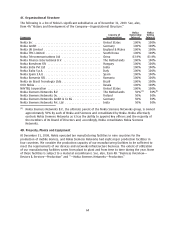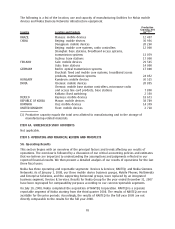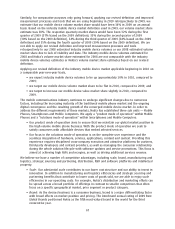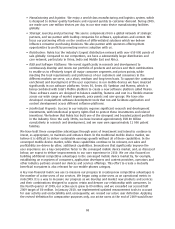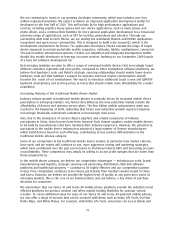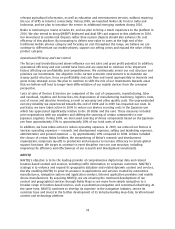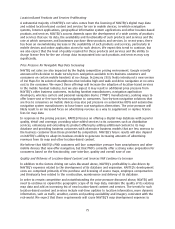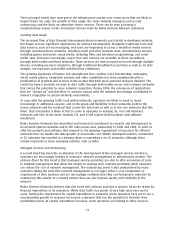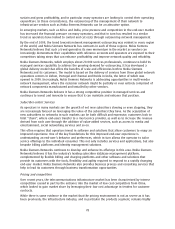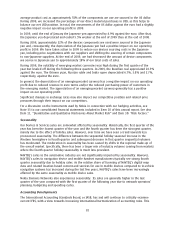Nokia 2009 Annual Report Download - page 73
Download and view the complete annual report
Please find page 73 of the 2009 Nokia annual report below. You can navigate through the pages in the report by either clicking on the pages listed below, or by using the keyword search tool below to find specific information within the annual report.to the consumer on many of our converged mobile devices, we believe the use and various usage
patterns will increase significantly as consumers rely more on these services and should open new
opportunities for Nokia and our partners to create additional valueadded content. We believe the
ability to understand the specific needs of different geographic markets and consumer segments and
to localize services appropriately will be a key competitive differentiator. For example, music is
popular across the globe, but each region has its own local music. In India, we offer over three
million tracks on our music store, which is significantly greater than our closest competitor, which
offers only about 100 000 tracks.
Most importantly, we are focused on improving the user experience of our four software platforms
which are discussed below. Each platform has a strategic role in our overall portfolio. At the low and
midrange, we have two software platforms, Series 30 and Series 40. Above that, we have Symbian,
designed to leverage our scale and global reach and to provide converged mobile devices at lower
price points. And with Maemo, which will become the MeeGo software platform in 2010, we aim to
deliver a leading user experience on a new class of focused highend devices.
Converged Mobile Devices:
In the converged mobile device category, our competitive advantages
continue to be relevant. However, in the converged mobile devices category, net sales and
profitability are increasingly driven by the user experience, which depends more on software that
makes the device easier to use and services that allow users to personalize their devices, rather than
hardwarebased features such as cameras and general design and aesthetics. As we focus on
delivering a rich user experience, we expect to reduce the number of smartphone models we offer.
This should allow us to reduce the complexity of our development processes, quicken our time to
market and focus more of our resources on user experience innovations.
Our
smartphones
are based on the Symbian software platform. We believe that we will be able to
improve the user experience of Symbian with the release of Symbian^3 targeted for mid2010, which
is expected to deliver a sleeker and more responsive user interface, enabled by graphics accelerated
hardware and software. Additionally, we expect to improve the user experience by adding multiple
home screen pages, introducing single tap interaction throughout the user interface and offering
multitouch pinchzooming and intuitive multitasking. Before the end of 2010, we expect to release
Symbian^4, with a further redesign of the user experience intended to simplify interaction and layout,
bring content to the fore and deliver a fast and consistent user interface.
Our
mobile computers
are based on the Maemo software platform, which will become the MeeGo
software platform during 2010. Importantly, MeeGo provides device manufacturers with the freedom
to tailor the user experience. With MeeGo, we plan to accelerate industry innovation and reduce
timetomarket for a range of new Internetbased applications and services, including Ovi, and
exciting user experiences. Our mobile computers are targeted to have the power, memory, full
Internet and multitasking capabilities we expect today with personal computers.
Converged mobile device volumes are also affected by the level of mobile device subsidies that
mobile network operators are willing to offer to endusers in the markets where subsidies are
prevalent. Recently, we have seen network operators shifting the focus of their subsidy programs to
emphasize higherend products that are sold in conjunction with contracts that include both voice
and data usage. In order for us to have a converged mobile device portfolio that operators will find
financially attractive to subsidize, it is important that we continue to develop our converged mobile
device user interface and create services that are easy to discover and intuitive to use. We intend to
continue to provide support for operator customizations, which are valued by operators because it
allows them to differentiate their offerings.
Mobile Phones:
Our mobile phones are based on our proprietary Series 30 and Series 40 software
platforms. In the mobile phones category, hardwarebased features such as cameras, memory, color
screens, music players, materials and general design and aesthetic improvements continue to drive
the majority of customer purchase decisions. Additional functionalities such as Internet connectivity,
services and applications are also becoming important at midrange price points. Thus, Nokia
71





